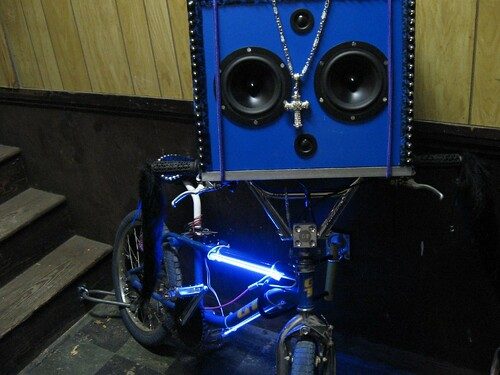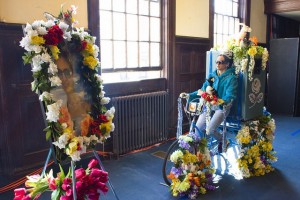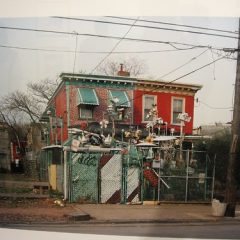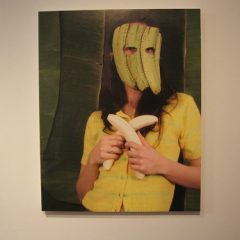
image of Chromelodeon, a Don Miller Nintendo-based fast-moving projected graphic, made for a concert in April at the First Unitarian Church in Philadelphia. The musician is named Eddie. (downloaded from www.no-carrier.com/)
There’s a special place–actually two of them in Philadelphia–where the techno-geek tinkerers and artists find common ground. That’s MakePhilly and The Hactory.
They are the product of a network of people who who have an urge to solve technical problems–from harnessing LEDs to using robotics.
This Sunday’s MakePhilly meeting just might be your cup of tea, when guest speaker Don Miller (aka NO CARRIER), will be sharing DIY info about hacking Nintendo action graphics for your own imagery. Miller’s own schtick is creating fast paced, colorful visuals for live music events and interactive art installations. To do it he hacks 8-bit Nintendo Entertainment System (NES) consoles, and he’s willing to share the basics of his whizz-bang techniques with others!
The event is participatory, so bring along your own PC laptop if you want to take up the challenge of creating original graphics using software that will emulate the real NES graphics (event specifics at end of post).
I’m wondering if animator Cory Arcangel does something similar!!
As in all Make meetings, after the speaker speaks, the mic goes public for sharing projects–successful and in progress–with the group. This is a crowd that likes to figure stuff out and solve everyone’s technological and mechanical problems.
One night when artist Maggie Van Scoyk rode up to FLUXspace with Roberta and me, she told is a little about Make. She’s a fan, and started talking terms like LED throwies to us. If you check out the Make website, you can find a link to work by artist Chris Vecchio, one of the Philadelphia artists who ruminates on the tongue-in-cheek meanings of technology and reality.

When we arrived at FLUXspace, Maggie ran into two others from the Make network, which by the way extends to other cities as well. Joshua Kopel and Vanja Buvac were both admiring a souped-up bike by Tyler student Andria Bibiloni. Bubac and Kopel are involved with The Hactory as well, and they started talking about Arduino network circuits (the DIY technical equivalent of the human networks that these two groups represent). Turns out we knew Vanja from ads he ran on artblog for his LED knowhow and its art applications.
The Hactory runs classes for a relatively low fee, and more than one level of expertise, starting at total beginner.
I had a nice chat with Josh a few days later. He’s a Cranbrook MFA grad in sculpture (metal-smithing) and a self-employed programmer. Here’s some of what he had to say.
Joshua: “Things have gotten sufficiently complicated that they’ve gotten simpler again–hobbyists can do interesting things without understanding what they do.”
L. What are those arduinos that you had been talking about?
Joshua: It’s as if people have been building this thing for the purposes of art interaction. Arduinos are a physical piece of hardware that you can program, building complex systems through a network of components. You can teach yourself to do this. The internet made it possible for anyone to publish their experiments and their results. The arduino team in Italy–You can use that site and can find out how to do stuff. It’s simple enough to get started, and complicated enough to get really interesting.
I was looking at a cellist’s website; he built this little device that lets him make electronic music essentially by tapping on the table top. The arduino recognized where on the table he is tapping, and plays atone!
An arduino is a small circuit board about the size of two business cards put together. It’s a microcontroller. It’s an entire computer system on one small chip. It’s an idea like your computer, with hard drive memory. But it’s slower, and so low power that a 9-volt battery is enough power. It can read information from the outside world like light sensors, sound sensors, push buttons, and then it turns around and controls things–like motors, LEDs and loud speakers.
Microcontrollers not a new thing. They have been around for many years and are in all kinds of manufactured things. When you push buttons on microwaves, your car, refrigerator temperature–they are all based on this idea.
L. What sorts of things have you made? How’d you get into this?
Joshua: I have always attempted to integrate interactivity into my sculpture. That was my motive, but I’ve never done this successfully. It always ends up with the interactivity and the sculpture fighting with eachother– the conceptual side of the sculpture versus the conceptual side of the electronics. I’m fascinated with making toys and having them interact.
L. And why did you form The Hactory?
Joshua: Because people all over the place like to form communities to do this stuff. There’s lots of technology to know. If you have lots of people with their information all together, you can share what you know and they know. It’s a natural for on- and off-line collaboration. We all want the same thing–to show off what we’ve done and find out what others have done.
L. Who else is involved in The Hactory?
Joshua: [he names Harris Romanoff (one of the MakePhilly founders), Jon McKamey and Vanja Buvac] The four of us started thinking about how to make this education program work. Then we met Stan Pokras–who has a non-profit for technical resources. His space and administrative assets where what we needed to get The Hactory going.
L. How is The Hactory different from Make?
Joshua: Almost all the people who come to Hactory meetings come to MakePhiladelphia meetings. The Hactory is a network of people who have gotten together to do things. MakePhiladelphia is a network of people who have gotten together to be together.
L. So one of the things The Hactory does is classes. Anything else?
Joshua: Jon [aka Far McKon] is building a fabrication workshop for The Hactory. The Hactory has three rooms at Non-Profit Technology Resources, where the classes are also held. The workshop is for sharing tools for specialized fabrication of unusual physical objects. …we’re not sure exactly how it will work, but an artist-in-residency program is in the works.
Most of the people involved do not think of themselves as artists, but they are engaged in creative activities.
L. How long have the two groups been around?
Joshua: The Hactory is pretty brand new. …I don’t know that it is what it will be. Nothing is set in concrete as yet.
MakePhilly, we’ve been running meetings for a year of 25 to 30 people a month.
There was a kid at the last meeting with a thing that projects words on the wall using a laser beam. But it looks like it’s built with bubblegum and string and cast-off parts. He had this idea–I want to make words on the wall with a laser beam. it turned into a quest looking for components, and learning more about programing and posting it all on his website. It’s very pure. It’s the best of the art world minus the commercial interest. It’s where someone wants to do something with no other motive than it works for their heart and their mind.
So if you want to attend the MakePhilly event on Nintendo graphics, The event is Sunday, Jan. 20, 3 p.m., University of the Arts, 333 S. Broad Street, Anderson Hall, 4th Floor. $5 donation suggested. But you need to rsvp your first & last name to makephilly@gmail.com








